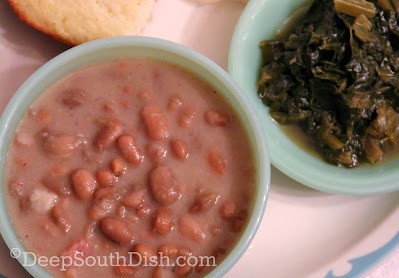Classic Southern style pinto beans, stewed with salt pork and cayenne pepper and always served with a side of cornbread.
Classic Southern Pinto Beans
We've had so many days of rain now that I've literally lost count, and according to our weatherman, there's more to come this week. Generally speaking, I don't mind the rain at all, well, so long as I don't have to drive anywhere in it at least. It's relaxing and cleansing, sort of washing away the world's residue and making everything fresh once it moves along.
Boy don't we need that in this world today!
I love the sound of the rain falling steadily against a window or spattering across a tin roof, and it's a good a reason as any on a Sunday afternoon to take in a marathon of old movies. Or a nap. Write a few new recipes and take my own sweet time in the kitchen. All of which I managed to do.
After days and days of being waterlogged though, it does get a little tiring. Being wet is one of my least favorite things in the world, but then again, so is oppressive heat and at least we've gotten a little break from that.
Was a good enough reason to make a pot of beans and cornbread too if you ask me!
Red kidney beans and white beans are the beans of choice down here in my part of the Deep South, much more so than pinto beans ever will be.}
I've prepared pintos before in the Deep South tradition, using a semi-Trinity, letting jalapenos stand in for the typical green sweet bell pepper, and seasoning with ham, bacon or the andouille smoked sausage that we love so much here. I serve those over rice and they are delicious... but they aren't what most folks in other areas of The South would call classic Southern pintos.
These are, and they are delicious.
In some areas of the South, particularly in the Appalachian regions, these are referred to as soup beans.
Not bean soup, but soup beans.
Nobody has been quite able to explain why they are called soup beans - well other than they are typically a little "soupy" though not as thin as a bean soup would be. Of course,, I have seen recipes from that area that are both similar to and very different from these. I guess like most all recipes, there are a multitude of variations in ways that folks make them.
Jeni, a passerby on my social media agreed the reason they are called soup beans "is because of the watery soup that is in the beans. We don't cook them dry, we always add extra water. This way, we can crumble our cornbread in the bowl with onions and chow-chow."
She also insisted that "you always have to have onions, chow-chow, and cornbread with soup beans. Always!"
Y'all know what I say about that!
It's your kitchen. Make them the way that you learned and grew up with, no matter what I, or anybody else says!
Since pinto beans are the beans most often used in the Appalachians, most recipes do use pintos, though there are others that use some butter beans or some form of white bean such as navy or great Northern, and some even southern peas, like black-eyed peas.
While pintos are probably the most traditional bean in soup beans, it appears that soup beans may also refer to any kind of bean prepared this way.
From there the beans are usually cooked down with some form of pork - ham bone, hocks, fatback, salt pork, bacon, smoked sausage and maybe a mirepoix of vegetables. Soup beans are often served with chopped raw onion, pickled onion or even sweet pepper relish, fried potatoes, and always, cornbread.
Since I like to use salt pork, I don't season them except for a little bit of plain cayenne until after they cook. Because, in my experience {and there's always someone to dispute that it seems} salt can make for tough beans sometimes if introduced too early, so save the Cajun seasoning for the end when they are done. Give them a taste and add in a little salt and pepper then too, if it needs it.
I also like to stir in a little bacon drippings from my little vintage grease pot I keep in the fridge.

Even if you don't eat a lot of bacon, you should be saving those drippings because over time they will accumulate and there are many ways to use them. I keep mine in the fridge, just to keep it fresh since I don't use the drippings that often to keep it out on the counter. If you're not one to keep drippings though, butter is a perfectly acceptable stand-in, but don't be tempted to skip that step, because I find it makes a definite difference in the richness of the beans. Here's how to make them.
Unable to view the printable above on your device? Tap/click here.
Material Disclosure: Unless otherwise noted, you should assume that post links to the providers of goods and services mentioned, establish an affiliate relationship and/or other material connection and that I may be compensated when you purchase from a provider. You are never under any obligation to purchase anything when using my recipes and you should always perform due diligence before buying goods or services from anyone via the Internet or offline.
130706
.

